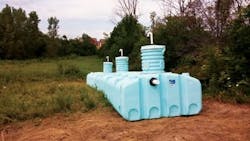Meeting the Challenge
About the author: Dave Stark is owner of Stark Rainwater Harvesting. Stark can be reached at [email protected] or 218.428.4413.
Above: Rainwater harvesting cisterns before underground installation
Michael Klement of Architectural Resource was forming a design team seeking full Living Building Challenge (LBC) certification for a residential project near Ann Arbor, Mich., and reached out to the American Rainwater Catchment Services Assn. (ARCSA) for resources. Stark Rainwater Harvesting, based in Duluth, Minn., had experience with cold weather applications and joined the team to consult and deliver an integrated rainwater harvesting system solution. The company’s background in surface water hydrology, rainwater harvesting, composting and greywater implementation helped position it for the job.
Goals & Technology
The home at Beacon Springs is named Burh Becc, which means “a dwelling by a creek” in Old English. Tom and Marti Burbeck, the owners, set goals to rehabilitate the damaged site, produce food for the local community following the principles of permaculture, and achieve LEED Platinum and full LBC certification.
Early design development focused on water use reduction strategies. Techniques included installing low-water-use fixtures, native plantings, a urine-diverting composting toilet system, greywater subsurface irrigation for an apple orchard and rainwater harvesting as the primary water source for indoor use.
A rainwater harvesting system would capture water from the home and garage to meet a year-round daily water demand of 67 gal. The system also would meet ARCSA/ASPE Standard 63 for rainwater harvesting. Stark Rainwater Harvesting worked with landscape architect Shannan Gibb-Randall of Insite Design Studios to design overflows from the cisterns to a series of swales terminating in a pond used for outdoor irrigation, ensuring surface water runoff does not impact adjacent water bodies.
The rainwater harvesting system consists of three 2,500-gal Den Hartog Aquifer below-ground cisterns, WISY four-step prefiltration and in-tank processes, a submersible ¾-hp Goulds pump and a treatment skid with a Viqua Pro 20-gal-per-minute ultraviolet treatment system. The skid includes a wireless tank monitor and water meters to measure rainwater use, well use and makeup water.
Three 2,500-gal underground cisterns were used to harvest rainwater for irrigation. The water services five outdoor spigots.
Meeting Code
Michigan plumbing code does not have a chapter directly addressing rainwater harvesting, but does include a section on greywater reuse, which permits rainwater harvesting projects in the state. The general contractor, Bob Burnside of Fireside Home Construction, engaged local regulatory officials to present the initial plans. Ultimately, the rainwater harvesting system only was permitted to be installed for outdoor irrigation. The composting and greywater applications were denied.
The existing site had a well and septic system both in need of rehabilitation to meet current codes. The systems are allowed within the LBC framework and thus were brought online. Part of the LBC requires that teams engage local officials even if a given practice is not currently permitted.
In the basement of the home, architects designed an area referred to as the “plumbing pit” to allow access to all mechanical systems. The home was plumbed to follow Michigan plumbing code and can be retrofitted when the code allows. The Burbecks chose to install the entire rainwater system, including disinfection, planning for when rainwater harvesting will be allowed inside the home. Irrigation demand will be higher during the first year of operation to establish the native plants, so the decision was made to serve five outdoor spigots with rainwater and utilize the well for all indoor use. The design team, builders and owners are anxiously awaiting the ICC/CSA code that likely will drive implementation of a rainwater harvesting code in Michigan.
Spreading Awareness
The rainwater harvesting system was installed in the spring of 2016. During the first year of operation, the home’s actual performance will be measured against the requirements of the LBC standard for full certification.
While working in Ann Arbor, the Stark team met a number of people facing similar questions, including students from the University of Michigan Blue Lab and a team attempting to permit a rainwater system for use as thermal storage at a commercial spa. These early adopter projects and other groups requested an ARCSA Accredited Professional course, which was held in Ann Arbor in May 2016.
The system includes prefiltration and ultraviolet treatment to meet Michigan plumbing code.
